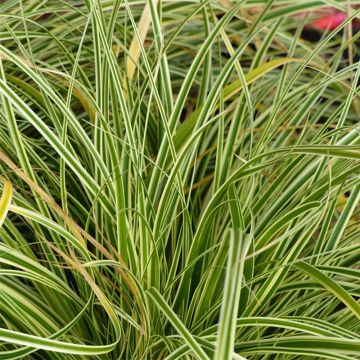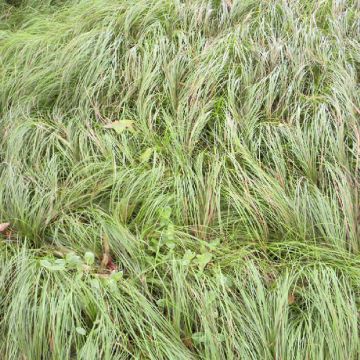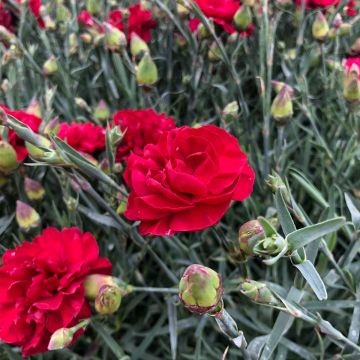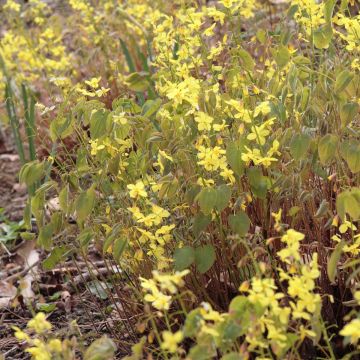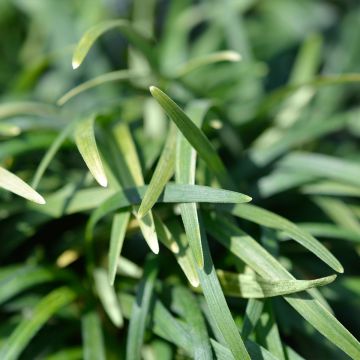

Carex oshimensis Everglow - Oshima Sedge


Carex oshimensis Everglow - Oshima Sedge
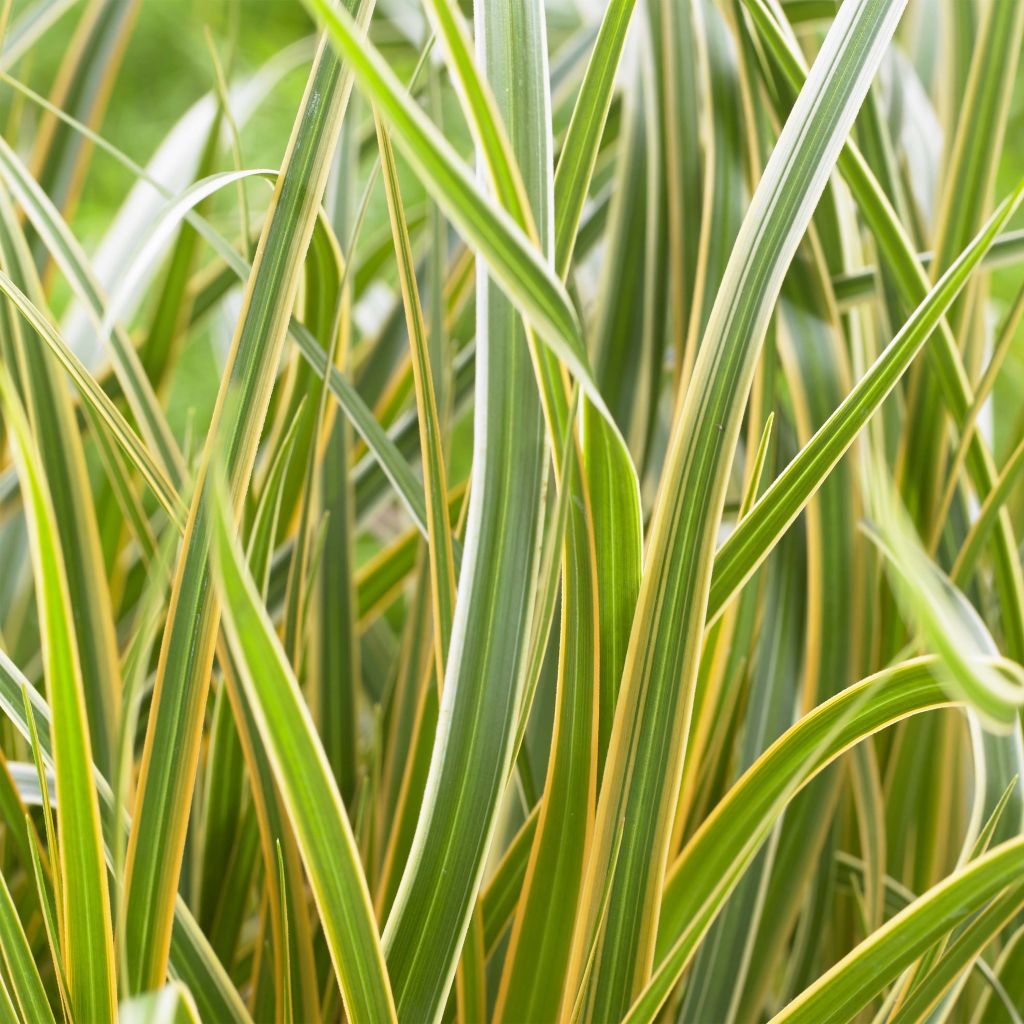

Carex oshimensis Everglow - Oshima Sedge
Carex oshimensis Everglow - Oshima Sedge
Carex oshimensis Everglow
Evergreen Sedge, Oshima Sedge, Japanese Sedge
This item cannot be shipped to the selected country
Delivery charge from €5.90
More information
Schedule delivery date,
and select date in basket
This plant carries a 12 months recovery warranty
More information
We guarantee the quality of our plants for a full growing cycle, and will replace at our expense any plant that fails to recover under normal climatic and planting conditions.
From €5.90 for pickup delivery and €6.90 for home delivery
Express home delivery from €8.90.
Does this plant fit my garden?
Set up your Plantfit profile →
Description
Carex oshimensis 'Everglow' is a particularly vibrant variety of Oshima sedge, perfect for adding life to flower beds, borders, or planters on a patio or balcony all year round. With its free, slightly tousled habit and long glossy leaves with a bright yellow margin tinged with a hint of orange, it forms a brilliantly coloured small tuft, ideal for adding style to any setting. Its autumn flowering is discreet, with small almost black-brown spikes. This false grass is easy to cultivate in full sun or partial shade, in any ordinary but moist soil.
Carex oshimensis 'Everglow' is a sedge belonging to the Cyperaceae family, and is a cousin of grasses to which it bears a resemblance. It is a recent variety from the EverColor® series, developed in Ireland for over 25 years. It comes from a hardy Japanese botanical species, widespread in rocky undergrowth on the island of Honshu. This small herbaceous plant with short rhizomes forms a tuft with a compact, light, upright and gracefully trailing habit, measuring about 40cm (16in) in all directions. It does not sucker, but fills out year after year. Its linear, evergreen gramineous leaves measure up to 30 to 35 cm (12 to 14in) in length. Their edges are tapered and their tips trailing. The bright green colour is highlighted by a yellow margin with copper or orange reflections, wider when the plant is grown in partial shade, narrower and more orange in full sun. In autumn, short black-brown spikes measuring 1 to 3cm (1in) appear among the foliage, borne on slender stems measuring 15cm (6in) in height. It should be noted that this Oshima sedge is very perennial and will live for many years in the garden.
'Everglow' is a small, refined 'herb' with delicate foliage that will form a beautiful bouquet of gracefully overflowing coloured leaves in pots. Its design does not require the presence of other plants alongside it, but it will complement its neighbours and bring lightness to the lush foliage of rodgersia, for example. Its texture contrasts with that of fern fronds, and its flexibility complements the roundness of fantastically coloured heuchera leaves and emphasises the beauty of hellebores. As this perennial appreciates moist to wet soils, it will naturally find its place in water gardens, on banks or at the edge of a pond, where it will contribute to soil stabilisation. Place it at the edges of perennial beds. For a beautiful wild effect, plant it en masse, in a contemporary or country garden.
Report an error about the product description
Carex oshimensis Everglow - Oshima Sedge in pictures


Flowering
Foliage
Plant habit
Botanical data
Carex
oshimensis
Everglow
Cyperaceae
Evergreen Sedge, Oshima Sedge, Japanese Sedge
Cultivar or hybrid
Other Carex
Planting and care
Carex oshimensis 'Everglow' adapts to all types of soil, as long as they are moist but well-drained. It prefers soils rich in humus and leaf compost. Once well-established, it can tolerate moderate periods of drought, but will require more regular watering during dry summers. This makes it an easy grass to grow and succeed with. It can also adapt to all exposures, but its foliage will be brighter in partial shade or dappled sunlight. Planting should take place outside of the frost periods. Water abundantly when planting. Avoid excessive fertiliser application. Remove damaged foliage during the growing season and prune the clump in late winter, just before the start of growth.
Growing in pots will require more abundant watering and fertilisation in spring.
Planting period
Intended location
Care
This item has not been reviewed yet - be the first to leave a review about it.
Ground cover perennials
Haven't found what you were looking for?
Hardiness is the lowest winter temperature a plant can endure without suffering serious damage or even dying. However, hardiness is affected by location (a sheltered area, such as a patio), protection (winter cover) and soil type (hardiness is improved by well-drained soil).

Photo Sharing Terms & Conditions
In order to encourage gardeners to interact and share their experiences, Promesse de fleurs offers various media enabling content to be uploaded onto its Site - in particular via the ‘Photo sharing’ module.
The User agrees to refrain from:
- Posting any content that is illegal, prejudicial, insulting, racist, inciteful to hatred, revisionist, contrary to public decency, that infringes on privacy or on the privacy rights of third parties, in particular the publicity rights of persons and goods, intellectual property rights, or the right to privacy.
- Submitting content on behalf of a third party;
- Impersonate the identity of a third party and/or publish any personal information about a third party;
In general, the User undertakes to refrain from any unethical behaviour.
All Content (in particular text, comments, files, images, photos, videos, creative works, etc.), which may be subject to property or intellectual property rights, image or other private rights, shall remain the property of the User, subject to the limited rights granted by the terms of the licence granted by Promesse de fleurs as stated below. Users are at liberty to publish or not to publish such Content on the Site, notably via the ‘Photo Sharing’ facility, and accept that this Content shall be made public and freely accessible, notably on the Internet.
Users further acknowledge, undertake to have ,and guarantee that they hold all necessary rights and permissions to publish such material on the Site, in particular with regard to the legislation in force pertaining to any privacy, property, intellectual property, image, or contractual rights, or rights of any other nature. By publishing such Content on the Site, Users acknowledge accepting full liability as publishers of the Content within the meaning of the law, and grant Promesse de fleurs, free of charge, an inclusive, worldwide licence for the said Content for the entire duration of its publication, including all reproduction, representation, up/downloading, displaying, performing, transmission, and storage rights.
Users also grant permission for their name to be linked to the Content and accept that this link may not always be made available.
By engaging in posting material, Users consent to their Content becoming automatically accessible on the Internet, in particular on other sites and/or blogs and/or web pages of the Promesse de fleurs site, including in particular social pages and the Promesse de fleurs catalogue.
Users may secure the removal of entrusted content free of charge by issuing a simple request via our contact form.
The flowering period indicated on our website applies to countries and regions located in USDA zone 8 (France, the United Kingdom, Ireland, the Netherlands, etc.)
It will vary according to where you live:
- In zones 9 to 10 (Italy, Spain, Greece, etc.), flowering will occur about 2 to 4 weeks earlier.
- In zones 6 to 7 (Germany, Poland, Slovenia, and lower mountainous regions), flowering will be delayed by 2 to 3 weeks.
- In zone 5 (Central Europe, Scandinavia), blooming will be delayed by 3 to 5 weeks.
In temperate climates, pruning of spring-flowering shrubs (forsythia, spireas, etc.) should be done just after flowering.
Pruning of summer-flowering shrubs (Indian Lilac, Perovskia, etc.) can be done in winter or spring.
In cold regions as well as with frost-sensitive plants, avoid pruning too early when severe frosts may still occur.
The planting period indicated on our website applies to countries and regions located in USDA zone 8 (France, United Kingdom, Ireland, Netherlands).
It will vary according to where you live:
- In Mediterranean zones (Marseille, Madrid, Milan, etc.), autumn and winter are the best planting periods.
- In continental zones (Strasbourg, Munich, Vienna, etc.), delay planting by 2 to 3 weeks in spring and bring it forward by 2 to 4 weeks in autumn.
- In mountainous regions (the Alps, Pyrenees, Carpathians, etc.), it is best to plant in late spring (May-June) or late summer (August-September).
The harvesting period indicated on our website applies to countries and regions in USDA zone 8 (France, England, Ireland, the Netherlands).
In colder areas (Scandinavia, Poland, Austria...) fruit and vegetable harvests are likely to be delayed by 3-4 weeks.
In warmer areas (Italy, Spain, Greece, etc.), harvesting will probably take place earlier, depending on weather conditions.
The sowing periods indicated on our website apply to countries and regions within USDA Zone 8 (France, UK, Ireland, Netherlands).
In colder areas (Scandinavia, Poland, Austria...), delay any outdoor sowing by 3-4 weeks, or sow under glass.
In warmer climes (Italy, Spain, Greece, etc.), bring outdoor sowing forward by a few weeks.

































